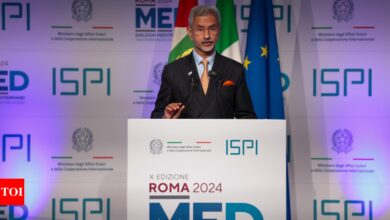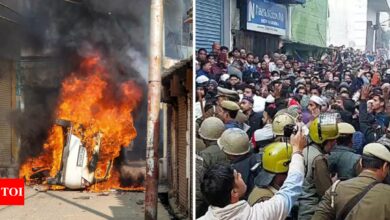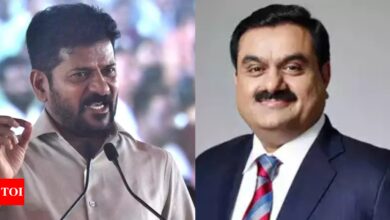India
‘Prime Minister Modi is a modern-day Bhageerath’ | India News – Times of India
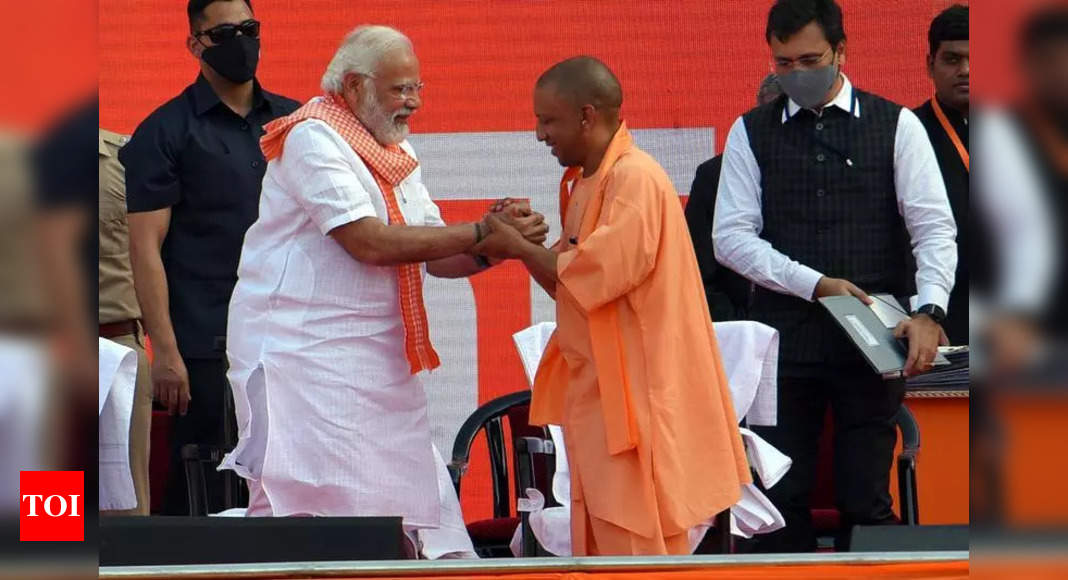
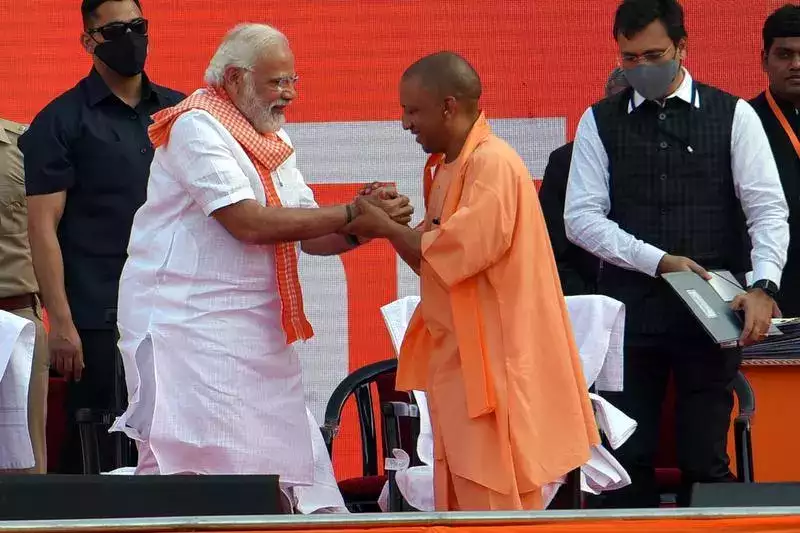

In the 21st century, India has taken on a key role in shaping the new world order. With global politics now multipolar, no major international group feels complete without India’s presence. From disaster relief to forging global policy consensus, the world is turning to India.
The visionary behind India’s rise as a global leader in the past decade is our esteemed Prime Minister, Shri Narendra Modi. Be it mediating the Russian-Ukrainian conflict or addressing crises in West Asia, India under Prime Minister Modi has played a pivotal role in resolving international issues.
Today, both Indians and world powers trust that “with Prime Minister Modi at the helm, anything is possible.” They see his leadership as the “guarantee” of solutions.
In the context of India, Prime Minister Modi is seen as a modern ‘Bhageerath‘, guiding the nation towards achieving goals, overcoming challenges and fulfilling aspirations. Whether it is a woman farmer working in a remote field, a young entrepreneur in a technology company, a soldier guarding the country’s borders or an Indian living abroad, they all share an unwavering trust in the Prime Minister’s policies, vision and decisions. This trust enables the Prime Minister to take bold and decisive steps.
A case in point is the abrogation of Articles 370 and 35A, which were once considered impossible. Initially, there was resistance, but today Articles 370 and 35A are history. Modi’s determination has ended the era of “two flags, two constitutions” in Kashmir.
Now, instead of unrest, we see progress — new industries are springing up and engineering marvels like the Chenab Railway Bridge, taller than the Eiffel Tower, are being built. J&K is now on the path of development and the world is watching. The people of this new Kashmir are prepared for the coming state assembly elections, where the prime minister’s vision of nationalism, good governance and development will prevail.
The Prime Minister has unleashed a cultural renaissance in India. After 500 years of wait, India’s spiritual and cultural aspirations have been realised with the consecration of Shri Ram Lalla in the grand new temple in Ayodhya and the renovation of the Shri Kashi Vishwanath temple.
Since 2014, India has freed itself from the grip of political parties that thrived on casteism, corruption and appeasement. Transparent and corruption-free implementation of government schemes has significantly improved the daily lives of ordinary people.
Behind this transformation is a new work culture driven by the principle of ‘Sabka Saath, Sabka Vikas, Sabka Vishwas, Sabka Prayas’. At the core of this philosophy, which strives for ‘Antyodaya se Sarvodaya’ (upliftment of the last leading to the upliftment of all), is the priority given to the marginalised. For the first time, agriculture and farmers have come centre stage in political discussions, with benefits of schemes like crop insurance, MSP, subsidies and mechanised farming reaching farmers without discrimination.
The Prime Minister has inspired people to aspire for more, enabling every Indian to actively participate in the country’s development during this ‘Amrit Kaal‘.
The Prime Minister took two important decisions in the first three months of his third term: the extension of Ayushman health insurance for all senior citizens aged 70 and over and the introduction of the Unified Pension Scheme to protect public interests. The decisions have ushered in a new era of economic security and hope.
Over the past decade, the implementation of JAM — Jan Dhan, Aadhaar and Mobile — has eradicated systemic corruption and ensured that the common man gets the full benefits of government schemes. PM Modi described JAM as delivering “maximum return on every rupee spent”, with a focus on empowering the poor and disseminating technology broadly among the population.
In UP alone, over Rs 10,000 crore has been saved in just 11 departments through Direct Benefit Transfer (DBT). The use of technology has not only improved the convenience of life but has also enabled the government to achieve maximum results in minimum time. Platforms like UPI, DigiLocker and DigiYatra have become an integral part of the lives of common citizens.
As environmental challenges continue to grow, the global community is increasingly realizing that unsustainable development is not real progress and could have lasting consequences for humanity.
This concept is in line with the ancient Indian philosophy, which has always placed great value on nature and the environment. Under the Prime Minister, India has become a global advocate for environmental protection.
The Prime Minister’s ‘Panchamrit’ and ‘Lifestyle for Environment’ (LiFE) campaigns have positioned India as a role model in the fight against climate change. Over the past decade, India’s installed solar capacity has increased by 2,300%, with solar costs falling by 70-80% since 2014.
Thanks to initiatives like the Pradhan Mantri Surya Ghar Yojana, the country is now benefiting from renewable energy sources, which is a major step towards a sustainable future.
Many large countries, still recovering from events like the COVID-19 pandemic and the Russia-Ukraine war, are struggling with economic problems. However, thanks to the diplomatic skills and financial expertise of the Prime Minister, India has not only weathered these difficult times but has also emerged as the world’s fifth-largest economy. The moment when India will become the third-largest economic superpower is fast approaching.
The International Monetary Fund (IMF) has recognized India as the fastest growing economy in its latest global growth forecasts. Today, the world is looking at India as an attractive investment destination. UP is one of the biggest beneficiaries of this surge in economic interest.
The ‘Semicon India’ conference held last week in UP marked the formal start of India’s journey to become a global hub for semiconductor production. From the Red Fort, the Prime Minister had declared, “My dream is that every device in the world will have a chip made in India.” The country is determined to establish itself as a semiconductor giant. With the Prime Minister’s “silicon diplomacy,” India is poised to become a global leader in semiconductor manufacturing.
It is a divine coincidence that the birth anniversary of Devshilpi Bhagwan Vishwakarma coincides with the birthday of our Prime Minister. Today, India is creating a glorious gift based on future aspirations, assuming the role of a world leader, with Prime Minister Modi as the visionary architect of this ‘Amrit Nav Nirman’. We are confident that his resolve to build a ‘developed and self-reliant new India’ will be realised through the participation of its people.
(The writer is the Chief Minister of UP, the views expressed are personal)
The visionary behind India’s rise as a global leader in the past decade is our esteemed Prime Minister, Shri Narendra Modi. Be it mediating the Russian-Ukrainian conflict or addressing crises in West Asia, India under Prime Minister Modi has played a pivotal role in resolving international issues.
Today, both Indians and world powers trust that “with Prime Minister Modi at the helm, anything is possible.” They see his leadership as the “guarantee” of solutions.
In the context of India, Prime Minister Modi is seen as a modern ‘Bhageerath‘, guiding the nation towards achieving goals, overcoming challenges and fulfilling aspirations. Whether it is a woman farmer working in a remote field, a young entrepreneur in a technology company, a soldier guarding the country’s borders or an Indian living abroad, they all share an unwavering trust in the Prime Minister’s policies, vision and decisions. This trust enables the Prime Minister to take bold and decisive steps.
A case in point is the abrogation of Articles 370 and 35A, which were once considered impossible. Initially, there was resistance, but today Articles 370 and 35A are history. Modi’s determination has ended the era of “two flags, two constitutions” in Kashmir.
Now, instead of unrest, we see progress — new industries are springing up and engineering marvels like the Chenab Railway Bridge, taller than the Eiffel Tower, are being built. J&K is now on the path of development and the world is watching. The people of this new Kashmir are prepared for the coming state assembly elections, where the prime minister’s vision of nationalism, good governance and development will prevail.
The Prime Minister has unleashed a cultural renaissance in India. After 500 years of wait, India’s spiritual and cultural aspirations have been realised with the consecration of Shri Ram Lalla in the grand new temple in Ayodhya and the renovation of the Shri Kashi Vishwanath temple.
Since 2014, India has freed itself from the grip of political parties that thrived on casteism, corruption and appeasement. Transparent and corruption-free implementation of government schemes has significantly improved the daily lives of ordinary people.
Behind this transformation is a new work culture driven by the principle of ‘Sabka Saath, Sabka Vikas, Sabka Vishwas, Sabka Prayas’. At the core of this philosophy, which strives for ‘Antyodaya se Sarvodaya’ (upliftment of the last leading to the upliftment of all), is the priority given to the marginalised. For the first time, agriculture and farmers have come centre stage in political discussions, with benefits of schemes like crop insurance, MSP, subsidies and mechanised farming reaching farmers without discrimination.
The Prime Minister has inspired people to aspire for more, enabling every Indian to actively participate in the country’s development during this ‘Amrit Kaal‘.
The Prime Minister took two important decisions in the first three months of his third term: the extension of Ayushman health insurance for all senior citizens aged 70 and over and the introduction of the Unified Pension Scheme to protect public interests. The decisions have ushered in a new era of economic security and hope.
Over the past decade, the implementation of JAM — Jan Dhan, Aadhaar and Mobile — has eradicated systemic corruption and ensured that the common man gets the full benefits of government schemes. PM Modi described JAM as delivering “maximum return on every rupee spent”, with a focus on empowering the poor and disseminating technology broadly among the population.
In UP alone, over Rs 10,000 crore has been saved in just 11 departments through Direct Benefit Transfer (DBT). The use of technology has not only improved the convenience of life but has also enabled the government to achieve maximum results in minimum time. Platforms like UPI, DigiLocker and DigiYatra have become an integral part of the lives of common citizens.
As environmental challenges continue to grow, the global community is increasingly realizing that unsustainable development is not real progress and could have lasting consequences for humanity.
This concept is in line with the ancient Indian philosophy, which has always placed great value on nature and the environment. Under the Prime Minister, India has become a global advocate for environmental protection.
The Prime Minister’s ‘Panchamrit’ and ‘Lifestyle for Environment’ (LiFE) campaigns have positioned India as a role model in the fight against climate change. Over the past decade, India’s installed solar capacity has increased by 2,300%, with solar costs falling by 70-80% since 2014.
Thanks to initiatives like the Pradhan Mantri Surya Ghar Yojana, the country is now benefiting from renewable energy sources, which is a major step towards a sustainable future.
Many large countries, still recovering from events like the COVID-19 pandemic and the Russia-Ukraine war, are struggling with economic problems. However, thanks to the diplomatic skills and financial expertise of the Prime Minister, India has not only weathered these difficult times but has also emerged as the world’s fifth-largest economy. The moment when India will become the third-largest economic superpower is fast approaching.
The International Monetary Fund (IMF) has recognized India as the fastest growing economy in its latest global growth forecasts. Today, the world is looking at India as an attractive investment destination. UP is one of the biggest beneficiaries of this surge in economic interest.
The ‘Semicon India’ conference held last week in UP marked the formal start of India’s journey to become a global hub for semiconductor production. From the Red Fort, the Prime Minister had declared, “My dream is that every device in the world will have a chip made in India.” The country is determined to establish itself as a semiconductor giant. With the Prime Minister’s “silicon diplomacy,” India is poised to become a global leader in semiconductor manufacturing.
It is a divine coincidence that the birth anniversary of Devshilpi Bhagwan Vishwakarma coincides with the birthday of our Prime Minister. Today, India is creating a glorious gift based on future aspirations, assuming the role of a world leader, with Prime Minister Modi as the visionary architect of this ‘Amrit Nav Nirman’. We are confident that his resolve to build a ‘developed and self-reliant new India’ will be realised through the participation of its people.
(The writer is the Chief Minister of UP, the views expressed are personal)


